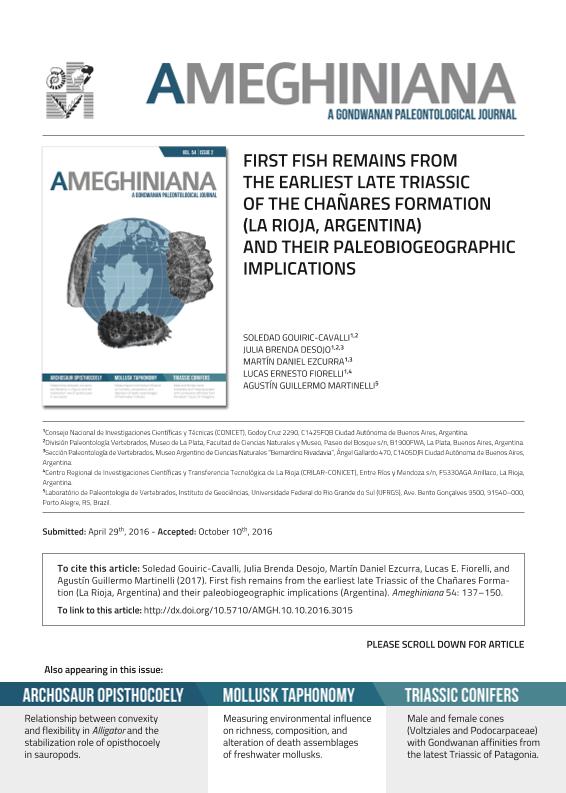Artículo
Describimos material de peces colectados en niveles continentales del Triásico Superior temprano de la Formación Chañares (localidades de Campo de Córdoba y El Torcido). Los materiales corresponden a un fragmento de un hueso dérmico del techo del cráneo el cual es asignado a Mawsoniidae sobre la base de su ornamentación que consiste en crestas gruesas y surcos anchos y poco profundos, y parches de escamas ganoides que son referidas como cf. Pseudobeaconiidae sobre la base de la presencia de una zona central elevada en la mayoría de las escamas. Sin embargo, a diferencia de lo observado en pseudobeaconiidos, estas escamas tienen un patrón de ornamentación que consiste en crestas de ganoina, concéntricas y/o paralelas cubriendo la superficie de la escama. Los parches de escamas representan los primeros fósiles de vertebrados colectados en el miembro superior de la Formación Chañares y brindamos un breve enfoque tafonómico a las mismas. El Mawsoniidae que se describe aquí es el registro más austral de la familia, el primer celacanto de Argentina y el primer mawsóniido Triásico de América del Sur. Los celacantos de agua dulce fueron confirmados en Laurasia para el Triásico Tardío; el nuevo registro de Gondwana podría denotar similares condiciones meteorológicas (clima cálido y árido, con precipitaciones estacionales) presentes en el norte y sur de Pangea durante este período. We hereby describe fish material collected from the lowermost Upper Triassic continental levels of the Chañares Formation (Campo de Córdoba and El Torcido localities). The specimens consist of a fragmentary dermal skull roof bone assigned to Mawsoniidae based on its ornamentation marked by coarse ridges and wide shallow grooves, plus patches of ganoid scales referred to cf. Pseudobeaconiidae based on the presence of an elevated central region in most of the scales. However, unlike that which is observed in pseudobeaconiids, these scales are characterized by an ornamentation pattern consisting of concentric and/or parallel ganoine ridges covering their surface. These scale patches, for which a brief taphonomic approach is hereby provided, are the first vertebrate fossil remains to be collected from the upper member of the Chañares Formation. The Mawsoniidae described herein represents the southernmost record of the family, being the first coelacanth from Argentina and the first Triassic mawsoniid from South America. Freshwater mawsoniid coelacanths established in Laurasia during the Late Triassic and the new Gondwanan record suggests that similar weather conditions (hot and arid but with seasonal precipitations) may have affected north and south Pangea during this period.
First Fish Remains from the Earliest Late Triassic of the Chañares Formation (La Rioja, Argentina) and Their Paleobiogeographic Implications
Título:
Los primeros restos de peces del Tiásico tardío más temprano de la Formación Chañares (La Rioja, Argentina) y sus implicancias paleobiogeográficas
Gouiric Cavalli, Soledad ; Desojo, Julia Brenda
; Desojo, Julia Brenda ; Ezcurra, Martin Daniel
; Ezcurra, Martin Daniel ; Fiorelli, Lucas Ernesto
; Fiorelli, Lucas Ernesto ; Martinelli, Agustín Guillermo
; Martinelli, Agustín Guillermo
 ; Desojo, Julia Brenda
; Desojo, Julia Brenda ; Ezcurra, Martin Daniel
; Ezcurra, Martin Daniel ; Fiorelli, Lucas Ernesto
; Fiorelli, Lucas Ernesto ; Martinelli, Agustín Guillermo
; Martinelli, Agustín Guillermo
Fecha de publicación:
04/2017
Editorial:
Asociación Paleontológica Argentina
Revista:
Ameghiniana
ISSN:
0002-7014
e-ISSN:
1851-8044
Idioma:
Inglés
Tipo de recurso:
Artículo publicado
Clasificación temática:
Resumen
Palabras clave:
Actinopterygii
,
Freshwater
,
Gondwana
,
Sarcopterygii
,
Triassic
Archivos asociados
Licencia
Identificadores
Colecciones
Articulos(CCT - LA PLATA)
Articulos de CTRO.CIENTIFICO TECNOL.CONICET - LA PLATA
Articulos de CTRO.CIENTIFICO TECNOL.CONICET - LA PLATA
Articulos(MACNBR)
Articulos de MUSEO ARG.DE CS.NAT "BERNARDINO RIVADAVIA"
Articulos de MUSEO ARG.DE CS.NAT "BERNARDINO RIVADAVIA"
Citación
Gouiric Cavalli, Soledad; Desojo, Julia Brenda; Ezcurra, Martin Daniel; Fiorelli, Lucas Ernesto; Martinelli, Agustín Guillermo; First Fish Remains from the Earliest Late Triassic of the Chañares Formation (La Rioja, Argentina) and Their Paleobiogeographic Implications; Asociación Paleontológica Argentina; Ameghiniana; 54; 2; 4-2017; 137-150
Compartir
Altmétricas



